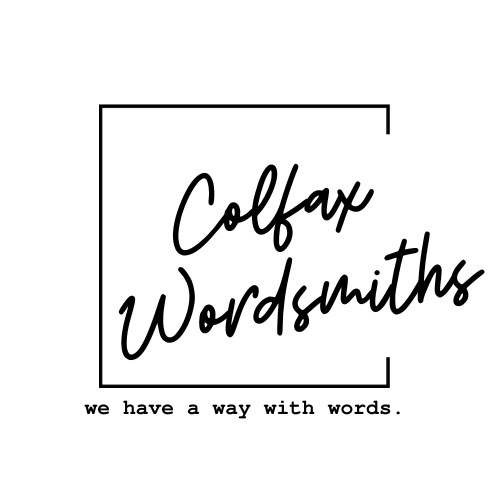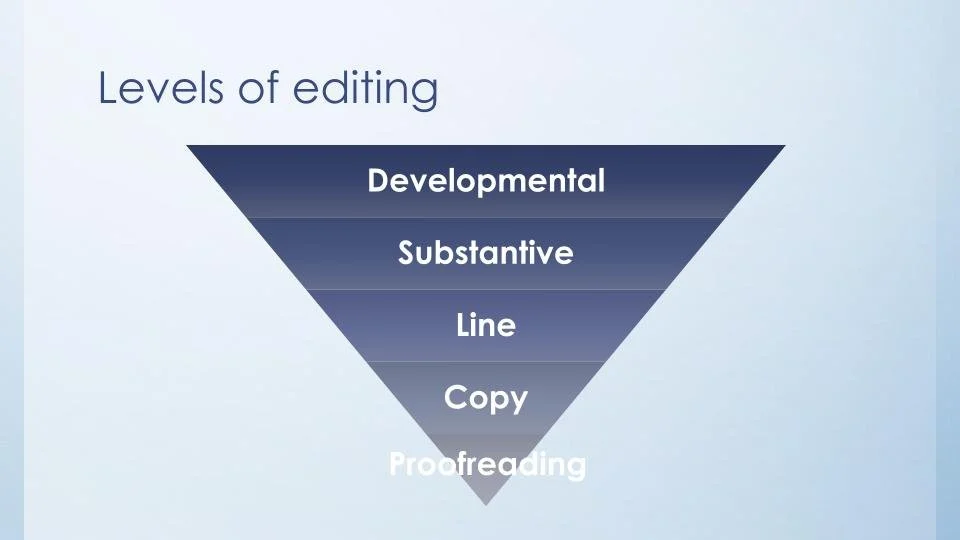The 5 Levels of Editing
or What Kind of Edit Do I Need?
The word “editing” can apply to a wide variety of different tasks. So what kind of edit do you need?
This is a question we’ve heard a lot here at Colfax Wordsmiths. That’s why we're excited to share this handy guide to the Five Levels of Editing, perfect for anyone diving into the editing world for the first time.
Today we're going to take a quick overview of the five levels of editing. For our purposes, editing means working with text. There are a lot of people who have the job title of editor who don't necessarily work with text. For example, acquiring editors choose the books for a particular publishing house but they might not get into actually editing text. So that's what we're talking about when we talk about the five levels of editing.
I like to think about the levels of editing as being an inverted pyramid, because the most significant level, which is developmental work, happens at the beginning or top of the pyramid. And these five levels of editing actually correspond really nicely to the breakdown of a manuscript, which I’ll explain as we go along.
So at the top, in developmental editing, you're dealing with changes and edits on the level of the entire manuscript. At this stage, an editor is usually helping an author come up with the structure for a manuscript or even helping them develop ideas. So if an author hired a developmental editor, they might say, “I have an idea for a biography of a musician, but I'm not sure what structure it should take.” Or they might say, “I'm really interested in this area of work, but I'm not exactly sure what kind of book I might write about it.” Developmental editors can help with those kinds of questions.
Next is substantive editing. This is the editing that's happening at the level of the section or the chapter of a manuscript. So we're making major changes, but we're not changing or coming up with the underlying structure of the manuscript, like in developmental editing. With substantive editing an editor might ask an author to move or delete several chapters or combine three side characters into one. Those are the kinds of edits that happen at the substantive level.
Then we move into line editing, which involves edits within and between paragraphs. This stage is what I think of as the musical level of editing, because it's thinking about a lot of issues that have analogs within the world of music. So rhythm, tone, voice, style, flow – all those elements come into play at this stage
And then we move into copy editing. Now we're looking at edits within a sentence, which includes grammar: How do the words fit together? How are the sentences structured? This is also the stage where editors make sure a text aligns with any style rules that are in effect. In the United States, the Chicago Manual of Style is the most popular style guide for book publishers, while the Associated Press or AP Style Guide is the definitive style guide for periodicals. Publishers and individual imprints within publishing houses often have their own style guides too.
And then finally, the fifth level is proofreading. At this stage, the manuscript has been laid out and pretty much looks like how it's going to look as a finished printed product, so proofreaders are making a lot of visual checks: making sure headers and footers are correctly, page numbers are where they're supposed to be, graphs and charts are laid out well, and so on. We're also looking at micro edits within words. So one example of what a proofreader might check would be kerning – the spacing between two letters – and leading – the spacing between two lines on a page. All of those very tiny detail changes are the proofreader’s domain.
Now, what about critiques? Critiques are somewhat similar to editing, but there are important differences to note.
The goal of a critique is usually to point out issues in a manuscript, but to leave it up to the author to decide how to fix them. An edit always suggests fixes for any issues that are pointed out. So if an idea is unclear, if a sentence is poorly constructed, if a word is misspelled, the edit will suggest a solution to fix it. A critique may do that, but not necessarily. Critiques also tend to have shorter accompanying letters than edits.
Other important things to keep in mind:
Even though they really shouldn't, editing levels can bleed into each other. Especially in time-crunch situations, a publisher might say, “I really need a freelance editor to do a line edit combined with a substantive edit,” or often you'll see line edits combined with copy edits. The problem is, it's really hard for any editor to do multiple levels simultaneously. It's almost impossible to catch every single thing for both levels when you're doing them at the same time. So in an ideal world, different editing levels should be done in separate rounds.
Also, many manuscripts don't go through all five levels. So for example, if a writer writes a manuscript with a solid structure, it might go straight through to line editing.
It's also pretty common for different editors to use different terms. Not every editor, for instance, thinks of substantive editing the way I do; they might do that work in a developmental edit. Or, they might say that line and copy editing cover the same thing. Which leads to the final point to remember . . .
Whether you're an author working with an editor or an editor working with an author, always put in writing what level of editing a manuscript is going to receive and exactly what elements of the work are going to be edited. And if you can't agree on those points, get or give a sample. If you're the editor, do a two- or three-page sample for the author so they know for sure exactly what you mean when you say you're going to give them a line edit. And if you're an author, always ask for a sample. The editor may or may not give you a sample edit of your work. Maybe they'll give you a sample of a past client's work, and that's okay. All you're trying to do is get to an agreement where you can both say, “This is what’s being paid for, and this is what’s going to happen to the manuscript.”
And that's it, the five levels of editing! You can find this and other resources on editing, writing, and more at www.colfaxwordsmiths.com Thanks!



